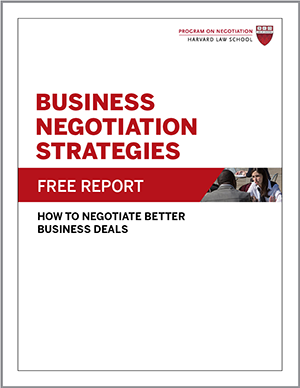
Whether before or after they sign a contract, business negotiators are often surprised by bad news that affects the viability of a deal or partnership. When determining how to negotiate a business deal, organizations need to shift their focus from closing the deal to thinking about how the partnership or other key outcome might play out over the long term.
In late 2016 and early 2017, news stories abounded of companies that were having second thoughts about planned mega-mergers. Abbott Laboratories began looking for ways to exit its acquisition of Alere, citing investigations of the medical test maker, for example. And Verizon started rethinking its acquisition of Yahoo! following a data breach at the tech company.
In their 2004 book Predictable Surprises: The Disasters You Should Have Seen Coming, Max H. Bazerman and Michael Watkins write that there are steps that individuals and organizations can take to ward off unwelcome surprises. But cognitive, organizational, and political barriers often prevent us from recognizing a looming surprise.
One way for business negotiators to avoid being predictably surprised is to overcome the cognitive biases associated with intuitive thinking. A particularly pernicious cognitive bias in negotiation is the tendency to discount the future. Research consistently shows that when making decisions, we tend to focus on short-term considerations and discount the future in a way that we regret later. Concerned about maximizing short-term shareholder value, for example, business leaders sometimes rush headlong into “quick fix” solutions, such as merging with another company.
How can business negotiators avoid being predictably surprised and bring long-term concerns to the bargaining table? Here are three guidelines for those looking for new guidance on how to negotiate a business deal:
1. Add long-term considerations to the conversation. You may understand the value of discussing what will happen during the implementation stage of a business contract, but you may have to convince leaders in your organization and your counterparts across the table to give future concerns the same attention. If short-term concerns—such as a current financial slump—are looming large, try to counter them through your negotiation behavior. Vividly portray the potential risks of rushing into an ill-thought-out deal, such as a broken agreement, bankruptcy, and so on. Seek unbiased advice from financial and legal experts about the risks of a deal. In addition, try to set deadlines for your negotiation that will give all parties plenty of time to weigh the pros and cons of a deal.
2. Take time to build rapport. The more time you spend getting to understand your counterparts and their organizations, the better equipped you will be to assess whether your partnership is a good idea or not. Even if you get along well with those seated across the table, seek out information about the organization’s culture and share information about your own. What values and norms are employees of both firms encouraged to ascribe to? How are employees selected, trained, and assessed? Spend time visiting one another’s headquarters and speaking to employees in different areas. If you are thinking of merging, discuss how your workers would be combined and what challenges you might face. Even if you are hammering out a simpler deal, such as a purchasing agreement, it pays to know whom you’ll be working with.
3. Prepare for adverse circumstances. Another common cognitive bias that exacerbates short-term thinking is the tendency to be overly optimistic about the future. Our unrealistic expectations about how a deal will play out lead us to search only for information that confirms our existing views and overlook information that might challenge them. This error explains why so many new businesses quickly fail. Negotiators need to envision not only best-case but also worst-case scenarios, including the possibility that conflicts will arise during the course of their partnership. You may be able to head off conflicts through two deal-design First, agree in advance to regular check-in meetings throughout the life of your contract to address any disagreements, dissatisfaction, or misunderstandings that arise. Second, prepare to handle such conflicts efficiently by including dispute-resolution clauses in your contracts that mandate the use of mediation.
In the flush of dealmaking, it’s easy to focus single-mindedly on closing the deal in negotiations. By playing devil’s advocate, you can teach yourself and your counterparts how to negotiate a business deal: by looking more realistically at the challenges that lie ahead and preparing to face them.
Effective negotiation strategies in business are critical. If you don’t know how to negotiate a business deal, get the information you need to succeed today by downloading our free special report, written by some of the nation’s foremost experts in negotiation, Business Negotiation Strategies: How to Negotiate a Better Business Deal. It will teach you how to negotiate a business deal and gives you the tools you need to navigate even the stickiest business deals.
How do you ensure long-term concerns are factored in when negotiating business deals?




